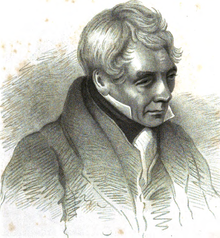Peter Nicholson (architect)
Peter Nicholson (20 July 1765 – 18 June 1844) was a Scottish architect, mathematician and engineer. Largely self-taught, he was apprenticed to a cabinet-maker but soon abandoned his trade in favour of teaching and writing. He practised as an architect but is best remembered for his theoretical work on the skew arch (he never actually constructed one himself), his invention of draughtsman's instruments, including a centrolinead and a cyclograph, and his prolific writing on numerous practical subjects.
Born in 1765 in the parish of Prestonkirk, East Lothian, Peter Nicholson was the son of a stonemason. Largely self-taught and excelling in the field of mathematics, he received only a rudimentary formal education, studying under a Mr Richardson, brother of architect George Richardson, at the local parish school from the age of nine until he left, aged 12, to assist his father in the family business. During this time he amused himself by making drawings and models of the numerous mills in the neighbourhood. However, finding stonemasonry not to his liking, he expressed the desire to be a cabinet-maker and so served a four-year apprenticeship at Linton, the principal village in the parish, then worked as a journeyman in Edinburgh before leaving for London in 1789 at the age of 24.
Living in London, Nicholson continued trading as a cabinet-maker but also began teaching practical geometry at an evening school for mechanical engineers in Berwick Street, Soho, at which he became so successful that he soon abandoned his trade and took up authorship. He published his first book, The Carpenter's New Guide in 1792, illustrating it with plates engraved by his own hand. It is notable for containing an original method for the construction of groins and niches of complex, double curved forms. Whilst living in London, Nicholson published three more books, The Student's Instructor (1795), The Carpenter and Joiner's Assistant (1797), and a three-volume work entitled Principles of Architecture, which he began in 1794 but did not complete until 1798.
...
Wikipedia

